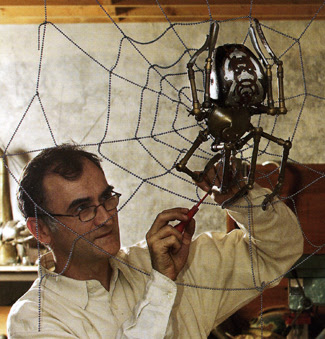Is reincarnation for real?
I offer undeniable proof…
I recently discovered a French sculptor whose work I find
so lyrical and full of recycled life as almost to be reincarnated into the
world of living creatures. So impressed am I by these exquisitely assembled
parts of discarded bicycles, typewriters, kitchen paraphernalia etc into
astonishingly anatomically correct representations of sea life, birds,
amphibians, insects that I feel compelled to share this treasure and its
creator…
Edouard
Martinet was born in Le Mans, France in 1963. He received a Bachelor of Fine
Art from L’Ecole Superieure des Arts Graphique in 1988. After working for two
years as a graphic designer he became a professional sculptor. He currently works
and lives in Rennes where he also teaches art.
There
is a sense of humor and wit about Eouard Martinet’s mechanical creatures as he
transforms others cast off junk into beautifully finished objects whose
appearance hint at their former lives of practical functionality. He mentions
that friends and family contact him when about to dispose of old and antique
odds and ends. These old pieces are taken to his workshop and given new life. “
I love seeing objects which have their own past and their own practical uses
take on a second life in my creations.” ..he says
Reincarnating
old parts is no walk in the park though. Martinet says that a design can take a
month to complete to as long as 17 years as he often needs specific pieces
before it can take on its new existence as a work of art. When assembling his
creations nothing is soldered or welded, all the parts are screwed together.
The
following are images of some of Edouard Martinet's fish, birds, insects that he
has brought into being.
By Meagan Meredith
 | ||
| Edouard Martinet at work in his studio. The Spider, made from bike brakes and tubes, balances on a web of plumbing chains. |














.jpg)
Absolutely exquisite. Thanks for sharing and thanks to Jane McIlleron for drawing my attention to this post.
ReplyDelete